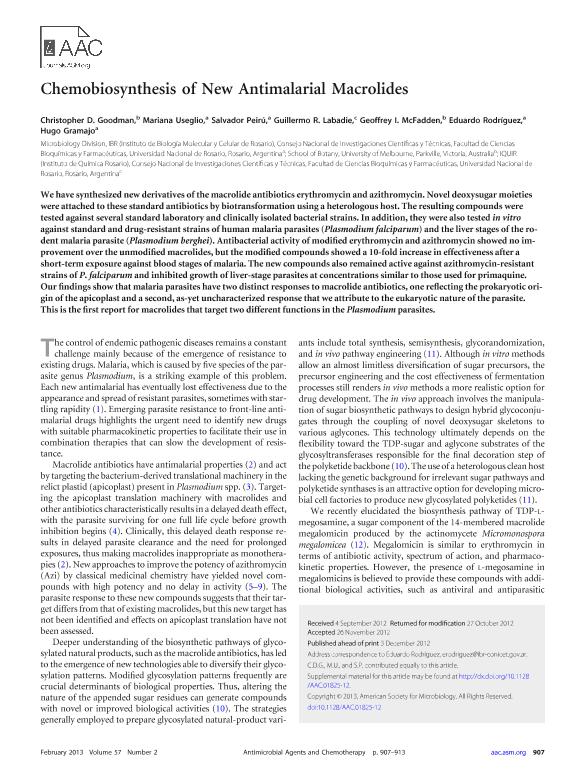Artículo
Chemobiosynthesis of New Antimalarial Macrolides
Goodman, Christopher D.; Useglio, Mariana ; Peirú, Salvador
; Peirú, Salvador ; Labadie, Guillermo Roberto
; Labadie, Guillermo Roberto ; McFadden, Geoff; Rodriguez, Eduardo Jose
; McFadden, Geoff; Rodriguez, Eduardo Jose ; Gramajo, Hugo Cesar
; Gramajo, Hugo Cesar
 ; Peirú, Salvador
; Peirú, Salvador ; Labadie, Guillermo Roberto
; Labadie, Guillermo Roberto ; McFadden, Geoff; Rodriguez, Eduardo Jose
; McFadden, Geoff; Rodriguez, Eduardo Jose ; Gramajo, Hugo Cesar
; Gramajo, Hugo Cesar
Fecha de publicación:
12/2012
Editorial:
American Society for Microbiology
Revista:
Antimicrobial Agents and Chemotherapy
ISSN:
0066-4804
Idioma:
Inglés
Tipo de recurso:
Artículo publicado
Clasificación temática:
Resumen
We have synthesized new derivatives of the macrolide antibiotics erythromycin and azithromycin. Novel deoxysugar moieties were attached to these standard antibiotics by biotransformation using a heterologous host. The resulting compounds were tested against several standard laboratory and clinically isolated bacterial strains. In addition, they were also tested in vitro against standard and drug-resistant strains of human malaria parasites (Plasmodium falciparum) and the liver stages of the rodent malaria parasite (Plasmodium berghei). Antibacterial activity of modified erythromycin and azithromycin showed no improvement over the unmodified macrolides, but the modified compounds showed a 10-fold increase in effectiveness after a short-term exposure against blood stages of malaria. The new compounds also remained active against azithromycin-resistant strains of P. falciparum and inhibited growth of liver-stage parasites at concentrations similar to those used for primaquine. Our findings show that malaria parasites have two distinct responses to macrolide antibiotics, one reflecting the prokaryotic origin of the apicoplast and a second, as-yet uncharacterized response that we attribute to the eukaryotic nature of the parasite. This is the first report for macrolides that target two different functions in the Plasmodium parasites.
Palabras clave:
Macrolidos
,
Plamodium
,
Malaria
Archivos asociados
Licencia
Identificadores
Colecciones
Articulos(IBR)
Articulos de INST.DE BIOLOGIA MOLECULAR Y CELULAR DE ROSARIO
Articulos de INST.DE BIOLOGIA MOLECULAR Y CELULAR DE ROSARIO
Citación
Goodman, Christopher D.; Useglio, Mariana; Peirú, Salvador; Labadie, Guillermo Roberto; McFadden, Geoff; et al.; Chemobiosynthesis of New Antimalarial Macrolides; American Society for Microbiology; Antimicrobial Agents and Chemotherapy; 57; 2; 12-2012; 907-913
Compartir
Altmétricas



